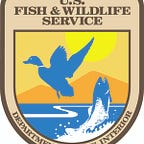Elusive, Wild Caterpillar Spotted!
Conservation detection dogs find Oregon silverspot butterfly caterpillars in their natural habitat
By Samantha Derrenbacher, fish and wildlife biologist, Newport Field Office
Merely the size of this comma: , . That is the size of a newly hatched Oregon silverspot butterfly caterpillar. And, as you can imagine, finding this miniscule caterpillar in the wild with our human eyes is next to impossible. But, for the first time in Oregon silverspot butterfly history, a unique conservation team has found a method in which we can consistently find wild caterpillars with an unlikely source — Allie and Pips.
Allie and Pips are mixed breed dogs employed by Rogue Detection Teams, a conservation detection dog program that participates in noninvasive surveys by employing “rescued dogs turned conservation superheroes.” In 2015, Deanna Williams, the Siuslaw National Forest Wildlife Biologist, connected with Ecologist Heath Smith from Rogue Detection Teams. Her concerns were that, without being able to find caterpillars in their native habitat, understanding the effects of habitat restoration on early life stages of the threatened butterfly are educated guesses at best.
Allie was initially trained to sniff out the frass — or poop — of Oregon silverspot caterpillars provided by the Oregon Zoo’s captive rearing program. Although Allie was successful at indicating many of the locations where frass occurred in the meadows, the team only found freshly munched on leaves, not the caterpillars themselves. Even without the caterpillars, the team taught us many new and useful facts about the rare Oregon silverspot butterfly — such as their need to have a wide variety of habitat microsites where they can adapt to yearly fluctuations in weather and predation.
In 2017, Rich Van Buskirk, Associate Professor of Environmental Science at Pacific University, added his considerable knowledge and experience to the team. While Allie retired at age 15, detection dog Pips joined them. Detection dogs are accomplished at completing surveys of hard to find targets in difficult terrain. To date, they have been able to find a wide range of sensitive species — wolves, cheetahs, orcas, spotted owls, and the Pacific pocket mouse. The only limit to the dogs’ ability to find rare species is our human limitation in understanding what they are showing us. As our human capabilities to find a comma-sized needle in a meadow-sized haystack are extremely limited, Deanna, Rich and the Detection Dog Teams worked hard to fund and develop a method to employ the dogs to search and indicate caterpillars in a way that allows humans to observe them.
Then in the spring of 2021, with the help of the Oregon Zoo and the U.S. Fish and Wildlife Service, Pips was able to be trained on captively reared caterpillars themselves, not just the frass. In just a few days, Pips indicated multiple locations of caterpillars in the meadows — with 13 individuals visually confirmed by humans. This ability to find Oregon silverspot butterfly caterpillars in the wild has opened up a massive door of opportunity. Partners are excited to continue this work to answer much needed questions of where the caterpillars are located in proximity to where eggs were laid, what they need to survive, and how our land management impacts them during this vital stage.
For more information, please contact Samantha Derrenbacher at samantha_derrenbacher@fws.gov or Deanna Williams at deanna.williams@usda.gov.
